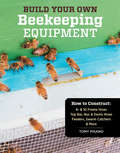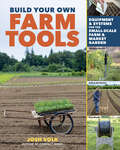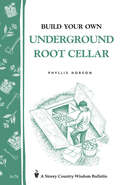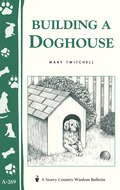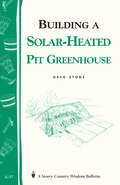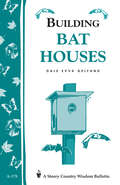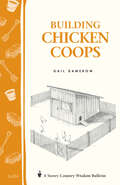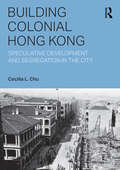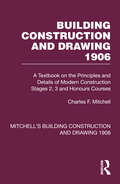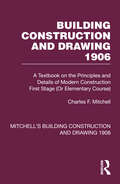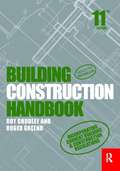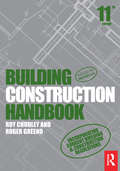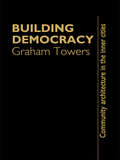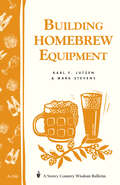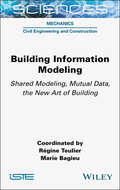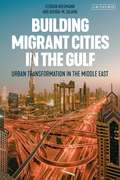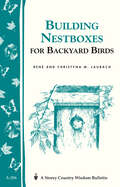- Table View
- List View
Build Your Own Beekeeping Equipment: How to Construct 8- & 10-Frame Hives; Top Bar, Nuc & Demo Hives; Feeders, Swarm Catchers & More
by Tony PisanoTony Pisano provides step-by-step illustrated instructions showing you how to build hive bodies, supers, covers, stands, frames, swarm catchers, feeders, and more using basic hand tools and easy-to-find materials.
Build Your Own Farm Tools: Equipment & Systems for the Small-Scale Farm & Market Garden
by Josh VolkFrom Josh Volk, author of the best-selling Compact Farms, these inventive tools and step-by-sep instructions for making and modifying them, help small, diversified farms simplify and streamline their operations for less wear and tear on human workers and for greater efficiency overall.
Build Your Own Underground Root Cellar: Storey Country Wisdom Bulletin A-76 (Storey Country Wisdom Bulletin)
by Phyllis HobsonSince 1973, Storey's Country Wisdom Bulletins have offered practical, hands-on instructions designed to help readers master dozens of country living skills quickly and easily. There are now more than 170 titles in this series, and their remarkable popularity reflects the common desire of country and city dwellers alike to cultivate personal independence in everyday life.
Building a Doghouse: (Storey's Country Wisdom Bulletins A-269) (Storey Country Wisdom Bulletin)
by Mary TwitchellBuild a Doghouse That's Just Right for Your Dog!While your dog may be a full-fledged member of the family, there are times when you must put him or her outdoors. Some dogs, for example, become over enthusiastically friendly when visitors appear, even to the point of knocking down your unsuspecting guests. Other dogs enjoy having some time to themselves in the backyard. Whatever the reason that shepherds the dog out the door, a nearby doghouse within a fenced-in area provides a protected, private space for your dog and peace of mind for you. A proper doghouse is a canine retreat, a place where your dog can hide from the hot sun, the cold rain, the harsh wind, and the worries of the world. Mary Twitchell takes you through all the options for building or buying a comfortable and cozy shelter for your canine companion. Whether you want to modify a barrel, buy a molded plastic shelter, or build a wooden doghouse, you'll find all the information you need right here, from choosing the right site to proper building techniques to encouraging your dog to use the new doghouse.
Building a Solar-Heated Pit Greenhouse: Storey's Country Wisdom Bulletin A-37 (Storey Country Wisdom Bulletin)
by Greg StoneA solar-heated pit greenhouse combines the energy-conserving features of the traditional pit greenhouse with newer techniques and materials used in standard heated greenhouses. The result is a simple, inexpensive structure that blends into its environment and needs little or no heat from any source other than the sun. Greg Stone’s simple, illustrated, step-by-step instructions show you exactly how to design, site, and build your own solar-heated pit greenhouse from start to finish.
Building Bat Houses: Storey's Country Wisdom Bulletin A-178 (Storey Country Wisdom Bulletin)
by Dale Evva GelfandSince 1973, Storey's Country Wisdom Bulletins have offered practical, hands-on instructions designed to help readers master dozens of country living skills quickly and easily. There are now more than 170 titles in this series, and their remarkable popularity reflects the common desire of country and city dwellers alike to cultivate personal independence in everyday life.
Building Chicken Coops: Storey Country Wisdom Bulletin A-224 (Storey Country Wisdom Bulletin)
by Gail DamerowSince 1973, Storey's Country Wisdom Bulletins have offered practical, hands-on instructions designed to help readers master dozens of country living skills quickly and easily. There are now more than 170 titles in this series, and their remarkable popularity reflects the common desire of country and city dwellers alike to cultivate personal independence in everyday life.
Building Colonial Hong Kong: Speculative Development and Segregation in the City (Planning, History and Environment Series)
by Cecilia L. ChuIn the 1880s, Hong Kong was a booming colonial entrepôt, with many European, especially British, residents living in palatial mansions in the Mid-Levels and at the Peak. But it was also a ruthless migrant city where Chinese workers shared bedspaces in the crowded tenements of Taipingshan. Despite persistent inequality, Hong Kong never ceased to attract different classes of sojourners and immigrants, who strived to advance their social standing by accumulating wealth, especially through land and property speculation. In this engaging and extensively illustrated book, Cecilia L. Chu retells the ‘Hong Kong story’ by tracing the emergence of its ‘speculative landscape’ from the late nineteenth to the early decades of the twentieth century. Through a number of pivotal case studies, she highlights the contradictory logic of colonial urban development: the encouragement of native investment that supported a laissez-faire housing market, versus the imperative to segregate the populations in a hierarchical, colonial spatial order. Crucially, she shows that the production of Hong Kong’s urban landscapes was not a top-down process, but one that evolved through ongoing negotiations between different constituencies with vested interests in property. Further, her study reveals that the built environment was key to generating and attaining individual and collective aspirations in a racially divided, highly unequal, but nevertheless upwardly mobile, modernizing colonial city.
Building Colonial Hong Kong: Speculative Development and Segregation in the City (Planning, History and Environment Series)
by Cecilia L. ChuIn the 1880s, Hong Kong was a booming colonial entrepôt, with many European, especially British, residents living in palatial mansions in the Mid-Levels and at the Peak. But it was also a ruthless migrant city where Chinese workers shared bedspaces in the crowded tenements of Taipingshan. Despite persistent inequality, Hong Kong never ceased to attract different classes of sojourners and immigrants, who strived to advance their social standing by accumulating wealth, especially through land and property speculation. In this engaging and extensively illustrated book, Cecilia L. Chu retells the ‘Hong Kong story’ by tracing the emergence of its ‘speculative landscape’ from the late nineteenth to the early decades of the twentieth century. Through a number of pivotal case studies, she highlights the contradictory logic of colonial urban development: the encouragement of native investment that supported a laissez-faire housing market, versus the imperative to segregate the populations in a hierarchical, colonial spatial order. Crucially, she shows that the production of Hong Kong’s urban landscapes was not a top-down process, but one that evolved through ongoing negotiations between different constituencies with vested interests in property. Further, her study reveals that the built environment was key to generating and attaining individual and collective aspirations in a racially divided, highly unequal, but nevertheless upwardly mobile, modernizing colonial city.
Building Construction and Drawing 1906: A Textbook on the Principles and Details of Modern Construction Stages 2, 3 and Honours Courses (Mitchell's Building Construction and Drawing)
by Charles F. MitchellOriginally published in 1881, but here reissuing the 1906 edition with a new introduction by Stephen J. Scaysbrook, the Mitchell’s Building and Construction Stage 2, 3 and Honours book offers an unparalleled insight into historic construction techniques and materials. Originally written to provide a concise handbook and guide for students and for practitioners, this reissue of Mitchell’s 1906 Advanced and Honours edition now provides a valuable addition to building pathology, allowing students and practitioners to research construction methods and materials pertinent to the period.
Building Construction and Drawing 1906: A Textbook on the Principles and Details of Modern Construction First Stage (Or Elementary Course) (Mitchell's Building Construction and Drawing)
by Charles F. MitchellOriginally published in 1881, but here reissuing the 1906 edition with a new introduction by Stephen J. Scaysbrook, the Mitchell Building and Construction books offer an unparalleled insight into construction techniques and materials. Originally written to provide a concise handbook and guide for students and for practitioners, this reissue of Mitchell’s 1906 First Stage or Elementary Course edition now provides a valuable addition to building pathology, allowing students and practitioners to research construction methods and materials pertinent to the period. Including over 1000 drawings, it is of no surprise to see Mitchell’s First Stage or Elementary edition start with a detailed explanation of the instruments and methods of drawing with pencil ink and tracing paper, emphasising the need to learn basic drawing skills and the need to think about a detail and the materials used to create a detail capable of lasting well over 100 years or more. The simple act of making a scale from a drawing with only one dimension may be lost to modern-day students, but not to Charles Mitchell, who describes the method and its use.
Building Construction and Drawing 1906: A Textbook on the Principles and Details of Modern Construction Stages 2, 3 and Honours Courses (Mitchell's Building Construction and Drawing)
by Charles F. MitchellOriginally published in 1881, but here reissuing the 1906 edition with a new introduction by Stephen J. Scaysbrook, the Mitchell’s Building and Construction Stage 2, 3 and Honours book offers an unparalleled insight into historic construction techniques and materials. Originally written to provide a concise handbook and guide for students and for practitioners, this reissue of Mitchell’s 1906 Advanced and Honours edition now provides a valuable addition to building pathology, allowing students and practitioners to research construction methods and materials pertinent to the period.
Building Construction and Drawing 1906: A Textbook on the Principles and Details of Modern Construction First Stage (Or Elementary Course) (Mitchell's Building Construction and Drawing)
by Charles F. MitchellOriginally published in 1881, but here reissuing the 1906 edition with a new introduction by Stephen J. Scaysbrook, the Mitchell Building and Construction books offer an unparalleled insight into construction techniques and materials. Originally written to provide a concise handbook and guide for students and for practitioners, this reissue of Mitchell’s 1906 First Stage or Elementary Course edition now provides a valuable addition to building pathology, allowing students and practitioners to research construction methods and materials pertinent to the period. Including over 1000 drawings, it is of no surprise to see Mitchell’s First Stage or Elementary edition start with a detailed explanation of the instruments and methods of drawing with pencil ink and tracing paper, emphasising the need to learn basic drawing skills and the need to think about a detail and the materials used to create a detail capable of lasting well over 100 years or more. The simple act of making a scale from a drawing with only one dimension may be lost to modern-day students, but not to Charles Mitchell, who describes the method and its use.
Building Construction Handbook
by Roy Chudley Roger GreenoIdeal for students on all construction courses Topics presented concisely in plain language and with clear drawings Updated to include revisions to Building and Construction regulations The Building Construction Handbook is THE authoritative reference for all construction students and professionals. Its detailed drawings clearly illustrate the construction of building elements, and have been an invaluable guide for builders since 1988. The principles and processes of construction are explained with the concepts of design included where appropriate. Extensive coverage of building construction practice, techniques, and regulations representing both traditional procedures and modern developments are included to provide the most comprehensive and easy to understand guide to building construction. This new edition has been updated to reflect recent changes to the building regulations, as well as new material on the latest technologies used in domestic construction. Building Construction Handbook is the essential, easy-to-use resource for undergraduate and vocational students on a wide range of courses including NVQ and BTEC National, through to Higher National Certificate and Diploma, to Foundation and three-year Degree level. It is also a useful practical reference for building designers, contractors and others engaged in the construction industry.
Building Construction Handbook: Incorporating Current Building And Construction Regulations (Building Construction Handbook Ser.)
by Roy Chudley Roger GreenoIdeal for students on all construction courses Topics presented concisely in plain language and with clear drawings Updated to include revisions to Building and Construction regulations The Building Construction Handbook is THE authoritative reference for all construction students and professionals. Its detailed drawings clearly illustrate the construction of building elements, and have been an invaluable guide for builders since 1988. The principles and processes of construction are explained with the concepts of design included where appropriate. Extensive coverage of building construction practice, techniques, and regulations representing both traditional procedures and modern developments are included to provide the most comprehensive and easy to understand guide to building construction. This new edition has been updated to reflect recent changes to the building regulations, as well as new material on the latest technologies used in domestic construction. Building Construction Handbook is the essential, easy-to-use resource for undergraduate and vocational students on a wide range of courses including NVQ and BTEC National, through to Higher National Certificate and Diploma, to Foundation and three-year Degree level. It is also a useful practical reference for building designers, contractors and others engaged in the construction industry.
Building Construction Handbook
by Roy Chudley Roger GreenoIdeal for students on all construction courses Topics presented concisely in plain language and with clear drawings Updated to include revisions to Building and Construction regulations The Building Construction Handbook is THE authoritative reference for all construction students and professionals. Its detailed drawings clearly illustrate the construction of building elements, and have been an invaluable guide for builders since 1988. The principles and processes of construction are explained with the concepts of design included where appropriate. Extensive coverage of building construction practice, techniques, and regulations representing both traditional procedures and modern developments are included to provide the most comprehensive and easy to understand guide to building construction. This new edition has been updated to reflect recent changes to the building regulations, as well as new material on the latest technologies used in domestic construction. Building Construction Handbook is the essential, easy-to-use resource for undergraduate and vocational students on a wide range of courses including NVQ and BTEC National, through to Higher National Certificate and Diploma, to Foundation and three-year Degree level. It is also a useful practical reference for building designers, contractors and others engaged in the construction industry.
Building Construction Handbook (PDF)
by Roy Chudley Roger GreenoIdeal for students on all construction courses Topics presented concisely in plain language and with clear drawings Updated to include revisions to Building and Construction regulations The Building Construction Handbook is THE authoritative reference for all construction students and professionals. Its detailed drawings clearly illustrate the construction of building elements, and have been an invaluable guide for builders since 1988. The principles and processes of construction are explained with the concepts of design included where appropriate. Extensive coverage of building construction practice, techniques, and regulations representing both traditional procedures and modern developments are included to provide the most comprehensive and easy to understand guide to building construction. This new edition has been updated to reflect recent changes to the building regulations, as well as new material on the latest technologies used in domestic construction. Building Construction Handbook is the essential, easy-to-use resource for undergraduate and vocational students on a wide range of courses including NVQ and BTEC National, through to Higher National Certificate and Diploma, to Foundation and three-year Degree level. It is also a useful practical reference for building designers, contractors and others engaged in the construction industry.
Building Democracy
by Graham TowersBuilding Democracy is a major contribution to the growing public debate about the revival of community values in the face of the self-evident short-comings of the free market, specifically in terms of community architecture. Providing a historical context and an authoritative account of a movement that is proving surprisingly extensive and enduring, the book also examines the relevance of the approach to today's social and environmental problems, particularly in the inner cities. Community architecture was promoted in the early 1980s as the achievement of a handful of pioneering architects finding new ways of working with groups of ordinary people, to help them develop their own homes and community facilities. Building Democracy records the achievements of this movement and analyzes its contribution in addressing the problems of inner cities. Beginning with the origins of the urban question in the industrialization of the 19th century, the book goes on to look at the large-scale urban redevelopment of the 1960s - the latest and most concerted attempt to remodel Victorian cities, and on to community action, from which grew new approaches to design, development and construction. This book is of practical value to planners, architects, surveyors and landscape designers concerned with socially relevant design, as students or professionals. It will also be of interest to many people in the voluntary sector and in local government.
Building Democracy
by Graham TowersBuilding Democracy is a major contribution to the growing public debate about the revival of community values in the face of the self-evident short-comings of the free market, specifically in terms of community architecture. Providing a historical context and an authoritative account of a movement that is proving surprisingly extensive and enduring, the book also examines the relevance of the approach to today's social and environmental problems, particularly in the inner cities. Community architecture was promoted in the early 1980s as the achievement of a handful of pioneering architects finding new ways of working with groups of ordinary people, to help them develop their own homes and community facilities. Building Democracy records the achievements of this movement and analyzes its contribution in addressing the problems of inner cities. Beginning with the origins of the urban question in the industrialization of the 19th century, the book goes on to look at the large-scale urban redevelopment of the 1960s - the latest and most concerted attempt to remodel Victorian cities, and on to community action, from which grew new approaches to design, development and construction. This book is of practical value to planners, architects, surveyors and landscape designers concerned with socially relevant design, as students or professionals. It will also be of interest to many people in the voluntary sector and in local government.
Building Homebrew Equipment: Storey's Country Wisdom Bulletin A-186 (Storey Country Wisdom Bulletin)
by Karl F. Lutzen Mark StevensSince 1973, Storey's Country Wisdom Bulletins have offered practical, hands-on instructions designed to help readers master dozens of country living skills quickly and easily. There are now more than 170 titles in this series, and their remarkable popularity reflects the common desire of country and city dwellers alike to cultivate personal independence in everyday life.
Building Information Modeling: Shared Modeling, Mutual Data, the New Art of Building
by Marie Bagieu Régine TeulierThis book presents how Building Information Modeling (BIM) and the use of shared representation of built assets facilitate design, construction and operation processes (ISO 19650). The modeling of public works data disrupts the art of construction. Written by both academics and engineers who are heavily involved in the French research project Modélisation des INformations INteropérables pour les INfrastructues Durables (MINnD) as well as in international standardization projects, this book presents the challenges of BIM from theoretical and practical perspectives. It provides knowledge for evolving in an ecosystem of federated models and common data environments, which are the basis of the platforms and data spaces. BIM makes it possible to handle interoperability very concretely, using open standards, which lead to openBIM. The use of a platform allows for the merging of business software and for approaches such as a Geographic Information System (GIS) to be added to the processes. In organizations, BIM meets the life cycles of structures and circular economy. It is not only a technique that reshapes cooperation and trades around a digital twin but can also disrupt organizations and business models.
Building Information Modeling: Shared Modeling, Mutual Data, the New Art of Building
by Régine Teulier Marie BagieuThis book presents how Building Information Modeling (BIM) and the use of shared representation of built assets facilitate design, construction and operation processes (ISO 19650). The modeling of public works data disrupts the art of construction. Written by both academics and engineers who are heavily involved in the French research project Modélisation des INformations INteropérables pour les INfrastructues Durables (MINnD) as well as in international standardization projects, this book presents the challenges of BIM from theoretical and practical perspectives. It provides knowledge for evolving in an ecosystem of federated models and common data environments, which are the basis of the platforms and data spaces. BIM makes it possible to handle interoperability very concretely, using open standards, which lead to openBIM. The use of a platform allows for the merging of business software and for approaches such as a Geographic Information System (GIS) to be added to the processes. In organizations, BIM meets the life cycles of structures and circular economy. It is not only a technique that reshapes cooperation and trades around a digital twin but can also disrupt organizations and business models.
Building Migrant Cities in the Gulf: Urban Transformation in the Middle East
by Florian Wiedmann Ashraf M. SalamaHuman history has seen many settlements transformed or built entirely by expatriate work forces and foreigners arriving from various places. Recent migration patterns in the Gulf have led to emerging 'airport societies' on unprecedented scales. Most guest workers, both labourers and mid to high-income groups, perceive their stay as a temporary opportunity to earn suitable income or gain experience. This timely book analyses the essential characteristics of this unique urban phenomenon substantiated by concrete examples and empirical research. Both authors have lived and worked in the Gulf including Qatar, Bahrain and the United Arab Emirates during various periods between 2006 and 2014. They explore Gulf cities from macro and interconnected perspectives rather than focusing solely on singular aspects within the built environment. As academic architects specialised in urbanism and the complex dynamics between people and places the authors build new bridges for understanding demographic and social changes impacting urban transformations in the Gulf.
Building Migrant Cities in the Gulf: Urban Transformation in the Middle East
by Florian Wiedmann Ashraf M. SalamaHuman history has seen many settlements transformed or built entirely by expatriate work forces and foreigners arriving from various places. Recent migration patterns in the Gulf have led to emerging 'airport societies' on unprecedented scales. Most guest workers, both labourers and mid to high-income groups, perceive their stay as a temporary opportunity to earn suitable income or gain experience. This timely book analyses the essential characteristics of this unique urban phenomenon substantiated by concrete examples and empirical research. Both authors have lived and worked in the Gulf including Qatar, Bahrain and the United Arab Emirates during various periods between 2006 and 2014. They explore Gulf cities from macro and interconnected perspectives rather than focusing solely on singular aspects within the built environment. As academic architects specialised in urbanism and the complex dynamics between people and places the authors build new bridges for understanding demographic and social changes impacting urban transformations in the Gulf.
Building Nest Boxes for Backyard Birds: Storey's Country Wisdom Bulletin A-206 (Storey Country Wisdom Bulletin)
by Christyna M. Laubach René LaubachThis concise guide offers easy-to-follow, step-by-step instructions for building eight different nestboxes. Each nestbox is designed to attract and house different kinds of backyard birds, including bluebirds, swallows, wrens, chickadees, nuthatches, Red-Bellied Woodpeckers, Northern Flickers, Wood Ducks, Hooded Mergansers, American Kestrals, Screech Owls, Northern Saw-Whet Owls, and Great Crested or Ash-Throated Flycatchers.
